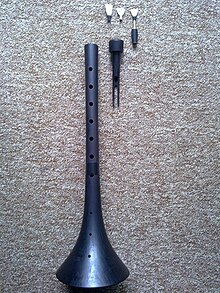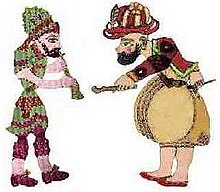Zurna
Zurna ( Turkish ) or surna , Ottoman سرنا, Kurdish zirne , Greek ζουρνάς , Arabic زرنة, DMG zurna , denotes a group of double reed instruments with a funnel-shaped bell in Turkey and in some neighboring countries that were influenced by the Ottoman musical culture . They belong to a large family of funnel oboes, which, with variations of the name sornay, spread from North Africa through the Orient, Central Asia and India to East Asia.
etymology
The name goes back to Persian sūrnā and Old Turkish suruna . The Turkish z is pronounced as a voiced s . In the 17th century the initial s was replaced by a z . This emerges from the description of musical instruments in the work of the Ottoman writer Evliya Çelebi . There are several explanations for the etymology of the Persian word sūrnā / zurna . Sūrnā (y) could be derived from the combination of Arabic صور, DMG ṣūr 'horn' and Persian ney ("pipe"), ie "horn flute". A sole origin from Old Persian is also conceivable. The earliest Turkish terms for comparable instruments used by the Asian Turkic peoples were yırağ and yorağ in the 10th century .
The cone oboes not only spread with the Ottoman Empire , they are likely to have come to some areas, for example the Balkans , even before the Turkish conquests, mostly by Roma who fled there . The zurna is a possible forerunner of the European shawm .
Design
Oboen cone are made of a single, cone-shaped piece of wood lathed . In Turkey, plum wood , ebony and apricot wood are preferred, with juniper wood , cherry wood or grenadilla wood also being used. Most types of the Zurna type are cylindrical in the grip area and drilled conically towards the lintel. They have a double reed (kamış) , 3–8 finger holes (perde) and a thumb hole offset towards the middle of the back, in addition sometimes a device with which alternative tones and sounds can be produced. However, this technology is no longer used today.
In principle, these are wind capsule instruments , as the player usually puts the mouthpiece so deep in his mouth that the reeds in it swing freely and cannot be corrected with the lips. A removable lip support made of plastic ( pirouette , Turkish: sedef ) helps him with this . This approach is often used in conjunction with circular breathing . In the bell, the lintels, one can occasionally find finger holes similar to “devil's holes” (şeytan delikleri) , whose tonal meaning and musical use can no longer be clarified today.
The zurna is usually available in three sizes, in Turkish called kaba ("large" in the sense of powerful sound, literally "thick"), orta ("medium") and cura ("small").
Style of play
Among the Ottomans came zurna with davul as a gift Seldschukenherrschers Kai Khosrow III. to Osman I (around 1258/1259; † 1326). Under Osman I, the zurna was initially part of courtly religious ceremonies, e.g. B. during the midday prayer, anchored (nevbet vurmak), but also found its way into the secular festival and entertainment music of the court and a little later into the military music mehterhâne of the janissaries .
At the same time, the zurna became firmly established in folk music, especially in the music of religious and secular festivals.
The duo davul - zurna
The big drum davul formed a duo with the zurna very early on, which became very important for different occasions and in different functions. The davul is always mentioned first with this duo, as it is very decisive both through its different sounds and its rhythmic guiding function. The variously struck sounds and noises create a kind of musical space like a drone . The zurna's melody swings above it or it subordinates itself to the rhythm.
In folk music, the zurna is being displaced more and more by the clarinet . The davul-zurna musicians are increasingly being replaced in rural areas by technical media and their traditional pieces of music by hits , pop music and rock music . But here, too, there is a kind of revival. Professional musicians take on zurna outside of the previous sociological context .
Davul-zurna in folk music
In many countries where the davul-zurna ensemble is common, certain groups of the population have been or are traveling with davul and zurna as traveling musicians who are committed to the festivals with songs, dances and instrumental lectures . Often the Roma (Turkish çingene, more rarely çigan or tsigan ), whose ancestors came to Anatolia with the Seljuks and converted to Islam there or largely on the way there . This gave the Roma in the Seljuk states rights like other Islamic subjects, also later in the Ottoman Empire. Traditionally they were craftsmen, traders and musicians.
Typical of the çingene musicians is still the duo davul - zurna.
Already Abū l-Qāsem-e Ferdousī writes in the Shāhnāme that Luri , who might correspond to the Çingene ( Roma ), were brought to Persia as musicians from India by Shah Bahram V. Gur in 420 AD . "So there is a lot to suggest that this instrument symbiosis and its practice come from India, sound tools like people." (K. u.U. Reinhard 1984)
The connection between davul-zurna and Çingene is exemplarily reflected in the main character of the Turkish shadow play , which was also cultivated in Greece , Montenegro and Romania . Karagöz is characterized as Çingene by its name (Eng. "Black Eye " in the sense of çingene ), by its Çingene secret language and sometimes by the attributes davul and zurna .
In Turkey there were and are mostly Alevi Abdāl traveling musicians. Above all they are singing ozan and aşık , but also instrumentalists with davul and zurna. They are considered to be of Turkic origin. Today, like the Çingene musicians, they are mostly sedentary.
Davul-zurna in the music of the mehterhâne
The impressive sound development of the davul and the cheering piercing sounds of the zurna made the duo of these two instruments, endowed with sovereign meanings, the core of the military music ensembles of the Ottomans. In the military music of the mehterhâne, also in the courtly representational and light music they developed, the davul-zurna ensemble, together with other wind and percussion instruments, formed an almost standardized, choral orchestra for outdoor events.
In 1826 the janissary corps were destroyed and their military music was also eliminated. The new Italian music director Giuseppe Donizetti , who was appointed to Istanbul in 1828 , formed military bands based on the European model. The zurna has been replaced by the oboe. It was not until late in the 20th century that a mainly tourist-oriented revival of the mehterhane came about.
Making music with two zurna
In the entire area where the Zurna family is used in folk music, it is customary to play music with zurna of different sizes at the same time. This happens with or without the company of the davul.
Three structural forms, sometimes mixed with one another, predominate:
- The smaller zurna plays the melody, the larger zurna plays drone notes.
- Two zurna play the same melody heterophonically .
- Two zurna take turns responsibly .
It is precisely in such duos that the melody-leading musician can demonstrate perfect mastery of his instrument. His playing is characterized by microtonic deviations, glissandos and decorations with fast trills and secondary notes as well as by a vibrato that is generated by the change in breathing pressure.
Outside Turkey
With the Ottoman conquests, the zurna came to southeast Europe, where this cone obo type is still widespread today: in North Macedonia as zurla , in Albania as surle , in Romania as surla and in Bulgaria as zournas . The töröksíp introduced into Hungary in the 16th century had disappeared by the middle of the 19th century.
Wandering Roma musicians and Jews in Turkey in the 19th century were largely responsible for the performance of the Karagöz Theater and for its musical accompaniment with davul and zurna . Such ensembles also appear in the Balkans, where the drum is mostly known as tapan (in Greece daouli ). In Greece and Albania the Roma musicians are called Yiftoi . Greek yiftoi are practically the only musicians who usually play as a daouli and zurna ensemble at weddings. The sorna also occurs frequently at village festivals and in connection with the drum dohol at Shiite passion plays (tazieh) in Iran .
In Armenia , the shrill music of the zurna is considered socially inferior. It is played together with the cylinder drum dhol at weddings and other family celebrations outdoors. In contrast to zurna , the softer sounding short oboe duduk and the Armenian longitudinal flute blul , which are used in cultivated chamber music , have a much higher reputation.
literature
- Ralf Martin Jäger, Ursula Reinhard: Turkey. In: The music in past and present (MGG), Sachteil, Vol. 9, Kassel 1998
- Andreas Masel, Artur Simon : Zurna. In: MGG, Sachteil, Vol. 2, Kassel 1995
- Lozanka Peycheva, Ventsislav Dimov: The Zurna Tradition in Southwest Bulgaria. Romani Musicians in Practice. Bulgarian Musicology Researches, Sofia 2002, ISBN 954-8307-27-8 .
- Laurence Picken : Folk Musical Instruments of Turkey. Oxford University Press, London 1975, pp. 485-508
- Christian Poché, Razia Sultanova: surnāy. In: Grove Music Online , 2001
- Kurt Reinhard , Ursula Reinhard: Music of Turkey, Volume 1: The art music (paperbacks for musicology; 95). Wilhelmshaven 1984
- Kurt and Ursula Reinhard: Music of Turkey, Volume 2: The folk music (pocket books for musicology; 96). Wilhelmshaven 1984
- Ursula Reinhard: double reed instruments. in MGG, Sachteil, Vol. 9, Kassel 1998
Web links
- Sönke Kraft: Zurna. sackpfeyffer-zu-linden.de
- Helmut Brand: The afterlife of ancient aulos music in European and Turkish-Arabic music. musikarchaeologie.de
Individual evidence
- ^ Henry George Farmer : Turkish Instruments of Music in the Seventeenth Century. As described in the Siyāḥat nāma of Ewliyā Chelebī . Civic Press, Glasgow 1937; Unchanged reprint: Longwood Press, Portland, Maine 1976: zūrnā pp. 22f
- ↑ Laurence Picken : Folk Musical Instruments of Turkey . Oxford University Press, London 1975, p. 485
- ↑ Christian Poché, Razia Sultanova: Nachbarāy. 1. Terms, distribution and history . In: Grove Music Online , 2001
- ^ Rudolf M. Brandl: The "Yiftoi" and the Music of Greece. Role and Function. In: The World of Music, Vol. 38, No. 1 (Music of the Roma) 1996, pp. 7–32, here p. 15
- ^ Ella Zonis: Classical Persian Music. An Introduction. Cambridge (Massachusetts) 1973, pp. 9 and 175-178




